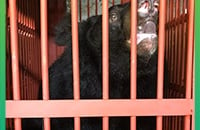Vietnam bear sanctuary saved from eviction
16 January 2013
 Animals Asia’s Vietnam bear rescue centre has been saved from the eviction threat that has been hanging over it since 5 October 2012. A communiqué issued by the Vietnamese government confirms that Prime Minister Nguyen Tan Dung has concluded that the rescue centre’s operation should be maintained, and that construction on the project’s second phase should continue.
Animals Asia’s Vietnam bear rescue centre has been saved from the eviction threat that has been hanging over it since 5 October 2012. A communiqué issued by the Vietnamese government confirms that Prime Minister Nguyen Tan Dung has concluded that the rescue centre’s operation should be maintained, and that construction on the project’s second phase should continue.
This decision ensures that the 104 bears living at the centre that have been rescued from the bile industry will stay, 77 local Vietnamese staff keep their jobs, and Animals Asia who fund and operate the centre will not suffer the financial losses of US $2 million as previously feared.
Animals Asia is a charity that is devoted to ending the barbaric practice of bear bile farming and improving the welfare of animals in China and Vietnam. The Vietnam Bear Rescue Centre, located in Tam Dao National Park, is dedicated solely to the rescue of previously farmed bears in Vietnam.
Tuan Bendixsen, Vietnam Director, Animals Asia commented:
“We are very grateful to the Prime Minister for his commitment to the bear rescue centre. We look forward to working with the government to end bear bile farming and help conserve the bear species..”
Jill Robinson MBE, Founder and CEO, Animals Asia commented:
“Our priority has been to rehabilitate these bears after their years of trauma from being locked up in small cages and milked for their bile. If we had been forced to relocate it would have had a terrible impact on their wellbeing. We want to sincerely thank the tens of thousands of supporters from around the world who wrote letters, sent e-mails and signed petitions calling for the eviction to be stopped.”
The rescue centre was established based on the Vietnam government’s 2005 agreement with Animals Asia to fund and develop a facility on 12 hectares of the park that would permanently rehabilitate and house 200 endangered bears rescued from the illegal bear bile industry. Based on this agreement, Animals Asia has invested more than US$2 million in building and infrastructure.
BACK




 Freedom after two decades: Moon bears Nang and Mua rescued
Freedom after two decades: Moon bears Nang and Mua rescued
 With heavy hearts we say goodbye to our beloved Tulip
With heavy hearts we say goodbye to our beloved Tulip
 Three moon bears rescued from notorious bear bile farming hotspots in Vietnam
Three moon bears rescued from notorious bear bile farming hotspots in Vietnam